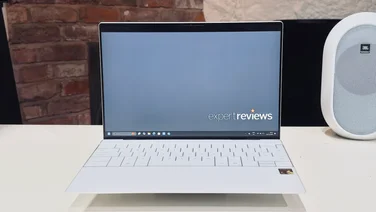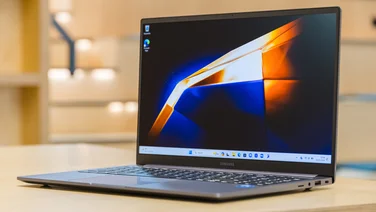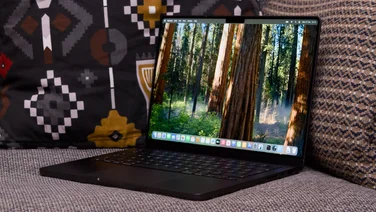To help us provide you with free impartial advice, we may earn a commission if you buy through links on our site. Learn more




When Gigabyte released its U2442F gaming Ultrabook, we didn’t think it was possible to pack more gaming power into such a slim 14in chassis, but the P34G has done just that. This 14in laptop is just 21mm deep but houses a super-fast 2.4GHz Intel Core i7-4700HQ processor and one of the most powerful dedicated mobile graphics chips we’ve ever seen.

It’s an incredible feat of engineering, as the laptop didn’t seem to suffer from a lack of ventilation at all during testing. Admittedly, the fans were noisy when we played games, but this is to be expected when all its components are crammed into such a tiny chassis. Paired with 8GB of RAM, the P34G scored an incredible score of 96 overall in our multimedia benchmarks, placing it just behind our reference desktop processor, a 3.4GHz Core i5-3570K. This is fantastic for such a portable laptop, so you can be sure the P34G will be able to handle almost anything you throw at it.
The P34G’s Nvidia GeForce GTX 760M graphics processor, which has 2GB of dedicated memory, is also incredibly quick. It waltzed through our Dirt Showdown benchmark test with a huge frame rate of 97.5fps with graphics quality set to High at a 1,280×720 resolution. This is even faster than the and Scan 3XS Graphite LG155, making it one of the most powerful gaming laptops we’ve ever seen. With so much power at the P34G’s disposal, you should have no trouble playing many games in Full HD, as the P34G delivered a smooth average frame rate of 64.7fps when we re-ran the test at 1,920×1,080 with the same quality settings.
The P34G even managed a good frame rate in Crysis 2, which most laptops tend to struggle with. We only managed 22.8fps in the PC version of the test, which runs on Ultra quality at 1,920×1,080, but lowering the settings to High produced a much smoother 52.1fps.

Powerful hardware is just one part of a good gaming laptop, though; it also needs a great display to show off games and video. The P34G uses an AHVA panel, which typically has less accurate colours than other types of display, but its image quality was surprisingly good. Our colour calibrator showed it was displaying 89.1 per cent of the sRGB colour gamut, which is much higher than the average 60 per cent we’ve seen from other laptop screens.
Images looked ever so slightly cool due to its marginally weaker red, blue and purple coverage, but overall our solid colour tests looked rich and vibrant. Whites were bright and evenly lit across the screen and blacks were near perfect. We recorded an exceptionally low black reading of just 0.03cd/m2.
Our high contrast images looked good, but its deep blacks had a tendency to obscure the finer detail in some of our night shots. This is a shame, as its contrast ratio of 1,101:1 is much higher than average. It didn’t affect our lighter images, but it had a big knock-on effect in games with dimly lit environments. With no way to improve the contrast, we could barely see where we were going when moving through shadows in Half Life 2, which may be a turn off for serious FPS fans.
Contrast issues aside, the P34G was great for everyday use. The keyboard was pleasant to type on, and keys were well-spaced with a decent level of tactile feedback. We would have like a little more vertical travel, but it certainly didn’t affect our accuracy and we were typing at full speed in no time.
The touchpad was fine for navigating the desktop, but we multitouch gestures were fiddly to execute. Pinch-zooming was particularly difficult to control, and swiping from the sides for Windows 8 shortcuts was also temperamental. We liked the button bar along the bottom, though, as this was easy to use and gave good feedback when we clicked through our files.

The P34G has a good selection of ports for a 14in laptop. As well as two USB3 ports and two USB2 ports, there’s VGA and HDMI inputs for connecting the laptop to an external display, a Gigabit Ethernet port, an SD card reader and a combined headphone and microphone jack. You’ll want to use this to connect a proper pair of speakers, as its integrated speakers were very tinny and had no bass whatsoever.

Battery life was average, which was a little disappointing considering the portability of the P34G. The laptop lasted just 4 hours and 17 minutes in our light use test with the screen set to half brightness, and playing games will drain it sooner.
The Gigabyte P34G isn’t cheap, but at this price it beats the competition. The Best Buy-winning Scan 3XS Graphite LG155 is cheaper, but it’s slower than the P34G and has a much thicker chassis. It’s a shame the P34G’s contrast isn’t better, but we’re willing to overlook it in the face of its outstanding design and phenomenally powerful hardware. If you value portability and want the best hardware money can buy, the Gigabyte P34G is for you.






